Environment And Its Resources
Ecology And Ecological Organization
Life and Environment: The natural surroundings of an organism, which affect its life, by directly influencing its activities, is called an environment.
- The environment includes both physical and biological environments. The physical environment includes air, water, soil, temperature, light, etc. The biotic factors include plants, animals, viruses and microbes.
- On Earth, we have all the requisite elements of life like water, air, and soil. Naturally, this Earth is our sweet home.
- For a healthy and happy life, we have to build good surroundings, where we could live generation after generation.
- Water is necessary for quenching our thirst, air for breathing, and soil for the production of food and other essential materials.
- In the world, we have enough natural resources like forests, oils, minerals, coal wildlife and many others.
Over and above, we have enough sunlight a source of all energies and a favourable temperature that influences the growth and distribution of plants and animals and makes our living enjoyable.
- Environment denotes the total of physical (abiotic) and biological factors (biotic) that directly influence the survival, growth, development and reproduction of the organism.
- In the modern concept, the environment is the total of living and non-living things which exert influence on the living organisms present in a particular area.
- Plants, animals, air, water, soil, temperature and light are the basic and essential elements of the environment. The former two i.e. plants and animals, are biotic elements, whereas air, water, soil, temperature and light are abiotic elements.
- Environment plays a key role in making life i.e. life is solely and wholly dependent on the environment.
Concept Of Ecology
The place where living organisms live with their surroundings forms their environment.
- Both physical and biotic environment together forms an environment. Soil, water, air, etc. form the physical environment. Whereas the biotic environment is formed of plants and animals.
- Living organisms and the environment are interdependent.
- The branch of science which deals with the interrelationship between the living organism and the environment is known as ecology.
- Therefore ecology is the study of interactions between organisms and their environment including other organisms.
- German biologist E. Haeckel (1869), first proposed the term ecology, which is derived from the Greek word ‘Oikos’ meaning “dwelling place or house” and “logos” meaning “study”. In ecology interactions of organisms and their organizations are studied at the following levels.
Individual Level
Ecological interactions of organisms and their organizations are studied about a particular kind—Adaptation to light, humidity and temperature.
- Introduction: The different mineral salts such as calcium, potassium, magnesium, sulphur, oxygen, nitrogen, carbon dioxide, water, soil, etc. form the abiotic factors of the ecosystem. The producers i.e. green plants secure these substances from soil and air to prepare their foods. Some physical factors are light, humidity and temperature.
- Light: Life cannot exist without light. Light is an essential physical ecological factor for photosynthesis and the production of food. The wavelength, intensity and duration of light play an important role in photosynthesis.
- In plants: The various functions performed by plants like photosynthesis, transpiration, germination, action of enzymes, phototropic movements or formation of growth hormones, hormonal actions, tissue differentiation, flowering, water absorption, development of palisade, production of chlorophyll, number and position of chloroplastids, movement of stomata, formation of flowers, fruits are influenced by light. The plants undergo various forms of adaptations to obtain light.
For reference only: Pnotophilic plants depend on bright sunlight whereas photophobic plants prefer low light conditions. The formation of flower fruits and seeds is favoured by strong light.
- Photoperiodism influences the growth, flowering and fruiting of plants.
- short-day plants (SDP) flowers are produced when the duration of light is less than 12 hours e.g. Dahlia,
- In long-day plants (LDP) flowers are produced when the duration of light per day is more than 12 hours (Spinach).
- In day-neutral plants (DNP) (cotton)- plants grow in short or long day conditions and blue and UV rays of light influence the growth and development of plants. Development of tissues takes place under red light.
In animals: Light plays an important role in animals. Distribution, colour pigmentation and certain structures of terrestrial animals are affected by light.
- The reproductive activities of birds are influenced by light. Animals like cockroaches, moths, and bats are active during the night. Bees orient at an angle rather than flying towards or away from the sun. Locusts do not fly in cloudy conditions.
- Their migratory movement, colouration, and development of special structures are influenced by light.
- The producers in the marine environment are present only in areas where light is sufficient, the consumers (for example animals) depending on plants for food are present in large numbers in or near-surface layers of water.
- The low intensity of light forms the causal factor of bioluminescence in the sea.
Humidity: The water vapour content in the air is represented by humidity. The pressure. of water vapour at a particular temperature is called absolute humidity. Regulation of different activities and distribution of organisms depends on humidity.
- The form and structure of plants are influenced by humidity. Humidity affects the rate of transpiration and water relations in plants.
- Plants growing in humid regions show elongated stems with long internodes and thinner leaves.
- Relative humidity affects animals. Rain forests where the air is saturated by moisture form the habitat of many animals. Desert animals thrive under extremely dry conditions. Birds and mammals living in warm humid regions exhibit dark colours.
- Humidity controls locomotion, feeding, and reproduction in insects and spiders.
- In Lepisma saccharina (silverfish) reproduction takes place at 85 to 90 percent relative humidity. Death of young ones takes place when humidity falls below 70 per cent. Excess humidity hurts normal feeding and development. Humidity higher than 88 per cent causes death of tsetse fly. Under moist air conditions, silkworms do not pupate.
Temperature: Temperature, a measure of the intensity of heat (expressed as degrees either in Fahrenheit or Celsius scale) is an essential and changeable environmental factor. It influences all forms of life and acts as a limiting factor for the growth and distribution of plants and animals.
- The temperature values at the equator are maximum, gradually decreasing towards the poles.
- Temperature decreases progressively from plains to high altitudes. Altitude affects values of temperature. At the poles, the temperature is < 0°C whereas in tropical deserts during summer temperature rises above 50°C.
For reference only: The division of earth’s vegetation into zones like equatorial, tropical, coniferous, and alpine, depends on variations in temperature at different latitudes. Temperature exceeds 100°C in habitats like thermal springs and deep-sea hydrothermal vents.
- Temperature influences vital activities of living organisms like metabolism, behaviour, reproduction, embryonic development and death. Temperature plays an important role in the activity of enzymes which in turn influences basal metabolism and physiological functions of organisms.
- Organisms which can tolerate a wide range of temperatures i.e. huge fluctuations are called eurythermal examples. toad, wall lizard. Organisms which can tolerate a narrow range of temperatures are called stenothermal example fish, and snails.
- The extent of geographical distribution of different species depends on their level of thermal tolerance. Plants are divided into four categories based on their heat-tolerating capacity
- Megatherms: plants which can tolerate high temperatures throughout the year for example desert vegetation and tropical rain forests. Tropical plants require constant high temperatures for their maximum growth
- Mesotherms: plants which can withstand high as well as low temperatures, for example, tropical deciduous forests, and aquatic plants.
- Microtherms: plants growing in regions of low temperature, for example, mixed coniferous forests
- Hekistotherms: plants growing in regions where the temperature is very low, examples of alpine vegetation. Alpine plants are adapted for short summer periods for flowering and fruiting. Plants receive energy from absorbed solar radiation and convection and they lose heat by radiation, convection and evapotranspiration.
Based On Temperature Control Animals Are Divided Into Three Groups:
- Poikilothermalor Ectothermicanimalsor Cold-blooded animals whose body temperature changes with a change in their environmental temperature example most invertebrates and vertebrates like fish and amphibia.
- Homeothermic or Endothermic animals or Warm-blooded animals whose body temperature is independent of the temperature of their environment, for example, birds and mammals.
- Heterotherms Animals with limited power of temperature regulation respond to extreme temperatures by aestivation and hibernation example some marsupials.
Know The Facts
- Hibernation: A state of inactivity shown by some animals during cold winter months to tide over unfavourable conditions, like scarcity of food and extremely cold weather. Physiological changes are lowering of blood pressure and body temperature, slowing down of heartbeat, pulse rate, metabolism and other vital processes. Animals under hibernation are dependent on fat reserves stored in their body. Examples of hibernating animals are hedgehogs, bats, amphibians, many fish, and reptiles. Cutaneous respiration is mainly shown in hibernating animals.
- Aestivation: Animals like lungfish show a state of inactivity during prolonged periods of drought or heat. At this phase, feeding, respiratory movements and other body activities slow down considerably.
Population Level
Population Level Definition: Population is the term given to a group of individuals of the same species inhabiting a particular geographic area at a given period. The total number of species in a specific natural habitat is called population density.
- This population density changes during a given period due to changes in some basic processes during a specific time. These basic processes are Natality, Mortality, Immigration and Emigration. Natality and Immigration result in an increase in population, whereas Mortality and Emigration result in a decrease in population.
- Population growth refers to an increase in the size of a population determined by the number of individuals added to the population and members of individuals lost from a population.
Population keeps changing with time, availability of food, predation pressure, and changes in weather conditions.
- Natality or Birth Rate: Population increases with an increase in birth rate. It is an expression of the production of new individuals in the population during a given period thereby adding to the initial population density. Natality is the expression of the birth rate of individuals in unit time.
- Mortality or Death Rate: Mortality is the expression of death or loss of individuals in a population during a given period. The rate of mortality may be expressed as the percentage of individuals dying within a particular time.
- Migration: It is a process in which animals move from one habitat to another according to the seasons. It is of two types:
- Immigration: Immigration may be expressed as an increase in population-level clue to the entry of members or individuals of the same species from other areas into a particular area during a particular time. Entry of population from one place increases population size and density in the immigrant place.
- Emigration: Emigration is a form of population dispersion where the individuals of a population exhibit movement from their habitat to areas previously unoccupied by the members of the population. This prevents overcrowding of the habitat during the period considered. Emigration may occur for food, environmental factors, breeding behaviour, and for gaining opportunities for interbreeding with other populations. Population density increases when several births and the number of immigrants is more than the number of deaths and number of emigrants.
Community Level
Competition: A set of interacting populations is called a community a group of animals or plants living or growing in the same place. Possible types of interactions among them are stated below
- In such kind of population interaction, the two individuals or species compete for a limited resource. The individuals are affected adversely by one another in their search for food, shelter or other requirements for existence.
- Such competition between individuals of the same species is called intraspecific competition, and such competition between two or more species is called interspecific competition takes place. With changes in environmental conditions entry of new invaders takes place and a reduction in several existing ones may occur.
- Intraspecific competition: Competition among the same species in a particular geographical area. for example. competition among tigers to catch deer in a forest.
- Interspecific competition: Competition takes place between individuals of different species of the same community for food, space and other requirements which are limiting, each is affected by the pressure of the other. At times resources may not be limiting but the feeding capacity of a species may be reduced due to interference caused by other species, for example. various carnivores in a forest may compete with one another to catch common prey like deer.
For reference only: Goats When Introduced on Galapagos Island, the greater browsing efficiency of the goats nurses the extinction of the Abington tortoise within a decade.
- According to Gnusc’s principle or Competitive exclusion principle, two non-interbreeding species with identical ecological niches cannot occupy the same environment.
- The competitively inferior one will be eliminated eventually.
For reference only: In competitive release when a competitively superior species is removed experimentally, a species whose distribution is restricted to a small geographical area expands.
- Field experiments by Connell showed that the larger and superior barnacle ‘Bctlanus’ dominates the intertidal area excluding the smaller barnacle Chathamalus from that zone.
- Competition affects plants and herbivores more than the carnivores.
- Recent studies however show that species facing competition may co-exist by changing feeding time or behaviour. in their foraging activities.
Predation: In such population interaction energy fixed by plants is transferred to a higher trophic level. In such interaction between two species one captures and kills another. Species which capture are called predators and those that are caught are called prey. Predators help in energy transfer across trophic levels and keep the population of prey under control.
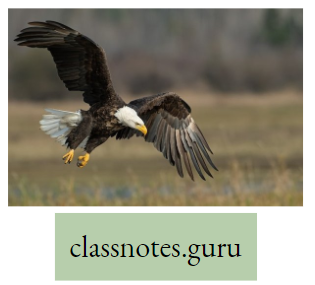
For reference only:

- With the Introduction Of exotic species in a particular area, they invade the area and spread very fast.
- Prickly pear cactus introduced in Australia multiplied rapidly prey.
- This in turn threatens the existence of predators which may become extinct due to a deficit of food.
- Defence mechanisms are adapted by some prey to protect themselves from predators. Insects and frogs camouflage themselves to escape from their predators.
- Some are poisonous or distasteful which keeps predators away from them.
- For example, the presence of a special chemical in the body of a Monarch butterfly keeps birds away from them.
- Insects feed on plant sap and other plant parts and herbivores are predators of plants.
- Plants are unable to move away from their predators so some of them show morphological and chemical defence mechanisms to keep away the herbivores.
For reference only: Thorns serve as defence organs in plants like Acacia and cactus. Some plants possess chemical substances which protect them from their predators. Herbivores consuming these plants turn sick and may die.
- The feeding and digestive processes of the herbivores are inhibited after the consumption of these toxic chemicals.
- A highly poisonous cardiac glycoside is present in the weed Calotropis which keeps away the herbivores.
- Plants producing alkaloids nicotine, caffeine, quinine, and strychnine, serve as defence mechanisms against their predators.
Parasitism:
Definition of Parasite: When an organism is unable to prepare its food and has to depend upon other host plants or animals to obtain food and shelter for its survival, causing harm to the host then it is called a parasite.
Explanation: In such kind of interaction one species (parasite) gains while the other (host) is harmed but not killed by the association. Parasite depends on hosts for food and shelter. Parasite benefits at the expense of hosts. Some being host-specific are dependent on a particular host species. They develop some mechanism to overcome the resistance developed by the host.
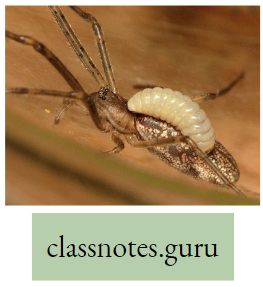
For reference only:
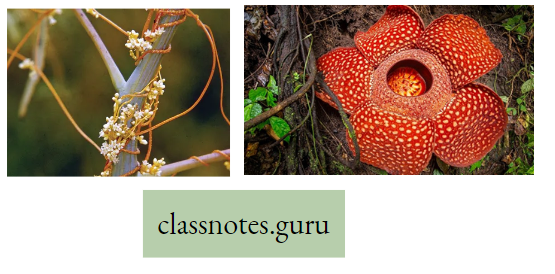
- Some Adaptive features of parasites are loss o nin essential sense organs development of organs for adhesion suckers to attach themselves to their absence of the digestive system increasing the ability to reproduce some parasites requires one or two vectors to complete their life cycle.
- Parasites are carried by mosquitoes serving as vectors. Parasites have harmful effects on the host. They may reduce the chances of survival of their hosts or adversely affect growth, reproduction and population density making them more vulnerable to their predators.
Different Types of Parasites :
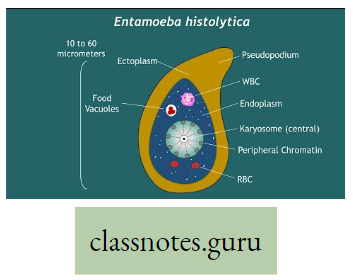
- Phytoparasite: Plant parasites for example, root nematodes, aphids, lac insects, stem borers, and wasps forming galls on plants like oats, and willows. Mites from Witches Broom in Hackberry.
- Zooparasite: Animal parasite for example. Platyhelminthes, nematodes, arthropods.
- Hyperparasite: Such parasites live on another parasite, for example, Plasmodium vivax, a protozoan is a hyperparasite on the female Anopheles mosquito which is a parasite of humans.
- Temporary parasite: Parasites like mosquitoes and bugs suck blood from their hosts. For example, Leech (Hirudinaria)’ sucks the blood of cattle and man.
- Permanent parasite: Entamoeba histolytica, certain Platyhelminthes, nematodes, and arthropods are examples of permanent parasites.
- Ectoparasites: live on the external surface of host organisms for example lice on humans, ticks on dogs, copepods on marine fishes, louse (Pediculus) sucks blood spreading diseases like typhus, Rat fleas [Xenopsylla] Spreads germs of plague from rat to man. Cuscuta is a rootless leafless parasite on hedge plants.
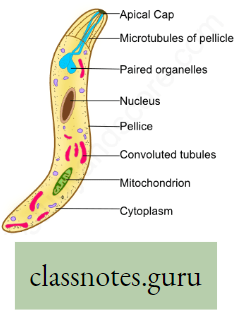
- Endoparasites: live inside the host body. For example,
- Entamoeba histolytica: a protozoan living in the human intestine that causes amoeboic dysentery.
- Plasmodium vivax: a protozoan living in human blood causes malaria.
Co-Operation:
- In this case, two individuals work together to achieve something. Both the species are profitable but their close association is not compulsory. They can live equally without association, e.g. the invertebrate animal Sea Anemone remains attached to the shells of hermit crabs. In this aspect both the species are benefitted (Positive).
- Another good example is cited here. The crocodile bird (Pluvionus aegyptius) enters the open mouth of a crocodile to feed on the blood-sucking parasitic leeches which live there. Food is obtained by the bird and instead of this, the crocodile gets relief out of those parasites which causes harm to them. Hence both partners can live well without their association.
Summary Of Types Of Population Interaction :
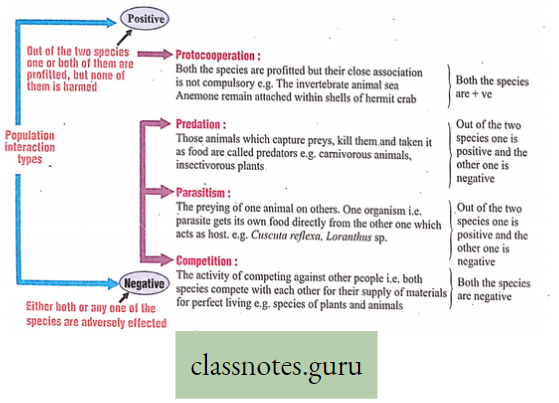
Ecosystem Level
Ecosystem Definition: The ecosystem is the functional unit of ecology, where biotic and abiotic factors interact in such a manner that through which matter cycles and energy flows. The term ecosystem was first proposed by Tansley.
In the structural aspect: Name different Abiotic factors through a chart
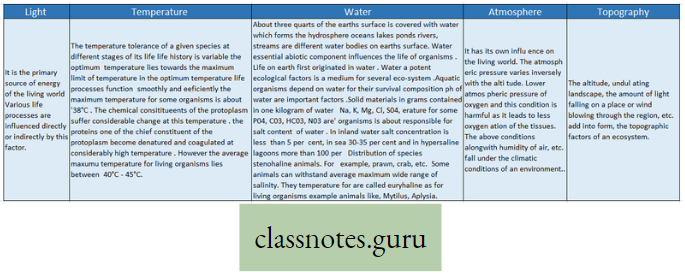
From the functional point of view, the living organisms of the Ecosystem are divided into two components by Odum (1917) Example
Biotic factor:
- Autotrophic components: Those living organisms of a biotic community for the preparation Of their food depending on the environment for water, carbon dioxide and for fixation of light energy are regarded as autotrophic components. All chlorophyll-containing green plants come under this category.
- Heterotrophic components: Those living organisms utilise, and decompose the complex substances produced by autotrophic components as they can’t prepare their food matters due to lack of chlorophyll are called heterotrophic components. Except few plants, most animals come under this category as they are directly or indirectly dependent on autotrophic components for food.
Biotic components: Biotic components are the constituents of a community. Each biotic community comprises of
- Producers
- Consumers and
- Decomposers.
1. Producers: The green autophytic plants are regarded as producers. They can synthesize carbohydrates, proteins, fats, etc, from certain inorganic constituents (C02/ H_,0, mineral salts, etc.) of the surrounding environment with the help of chlorophyll in the presence of sunlight.
The producers prepare their food matters through the process of photosynthesis which is as follows

Know the facts
- The term ecosystem was first used by a Christian Scientist Tansiey in the year 1935.
- German biologist E. Haeckel (1369) first proposed the term ecology.
- The different components of an ecosystem are interdependent. The environment is a term taken as a whole which includes all the conditions in which an organism lives, for example, light, temperature, humidity, water and other organisms.
2. Consumers :
Consumers are of three kinds
- Primary consumers
- Secondary consumers and
- Tertiary consumers.
- Primary consumers: The plant eaters are called primary consumers or first-order
consumers. The minute animals in the upper level of water constitute zoo plankton example, Daphnia, and protozoa. The primary consumers in the lower level of water are called bottom forms e.g., arthropods, snails, small fishes, etc. Primary consumers of land are herbivorous animals, for example, grasshoppers, pigeons, rabbits, monkeys, deer, cows, etc. - Secondary consumers: The carnivorous animals feeding on the primary consumers are called secondary consumers or second-order consumers, for example, spiders, toads, frogs, moles, etc.
- Tertiary consumers: The animals living on the secondary consumers are called tertiary consumers or third-order consumers, for example, tigers, lions, leopards, whales, sharks, hawks, eagles, etc.
- Primary consumers: The plant eaters are called primary consumers or first-order
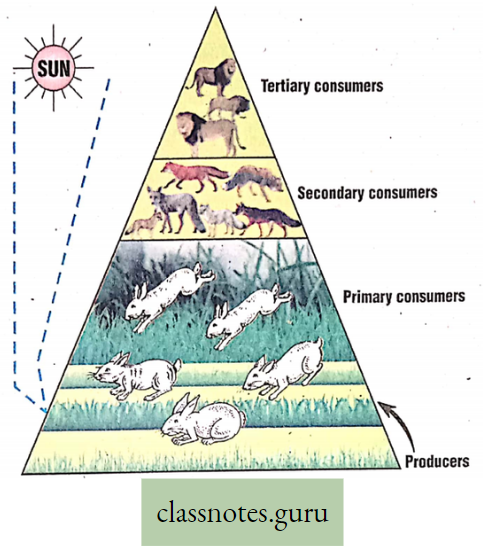
3. Decomposers: It is also called reducers or microconsumers. Certain heterotrophic bacteria and fungi break down the complex compounds of dead protoplasm, absorb some of the decomposed products and may release certain simpler substances for further utilisation by the producers. These together form the decomposers.

Transformers: Certain bacteria comprise this class. They are capable of reducing simpler substances decomposed by decomposers to further simpler forms and return these to the environment. These are consumed by the different forms of producers.
- Plankton: It indicates any dead or living organism (plants or animals), that floats passively in water and which is more or less dependent on water currents or wind action for their movements.
- Phytoplankton and Zooplankton: Free floating minute plants mostly unicellular or multicellular and solitary or colonial algae constitute what is called phytoplankton (Gr. Phyto, plants; plankton, floating), e.g. Spirogyra, Nostoc. They are autophytes parasites or saprophytes. Whereas free floating minute animals are called zooplankton, (Gr. Zoon animal, plankton floating), e.g. small arthropods.
Functional Aspects:
Food Chain: Definition and Types:
Food Chain Definition: “The transfer of food energy from the source in plants through a series of organisms with repeated eating and being eaten is known as the food chain”—Odum. The food chain may be defined as the sequential arrangement of producers and consumers of a particular ecosystem according to the predator relationship where eating being eaten takes place. At each transfer, 80%-90% of potential energy is dissipated as heat.
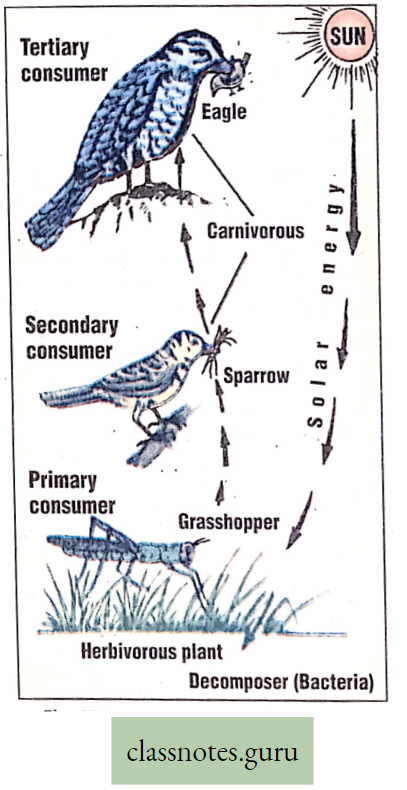
- In an ecosystem, the producer-consumer arrangement represents a trophic structure; where each food level is a good chain is called a trophic level.
- Green plants occupy the producer level (first, trophic level), plant- -eaters from the level of primary consumers (second trophic level), the carnivores that feed the Food chain of insects and birds, on the plant eaters, occupy the secondary consumer level (third trophic level) and the secondary carnivores the tertiary consumer level (fourth trophic level).
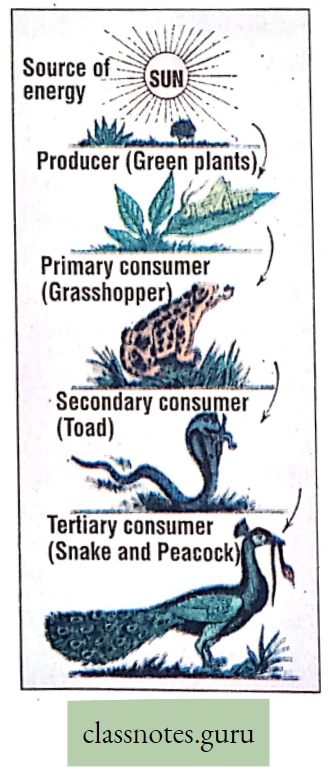
Types Of Food Chains: There are three types of food chains: predator food chain, parasitic food chain and saprophytic or detrital food chain.
- Predator food chain: A predator food chain starts from green plants and extends up to carnivores i.e., it includes consumers only. Here the size of the living organism gradually increases, but their number gradually diminishes.
- Predator food chain – Grass → Grasshopper → Frog → Snake →Eagle
- Parasitic food chain: A parasitic food chain goes from larger (host) to smaller (parasite) animals.
- Parasitic food chain – Plant → Pig → Helminth
- A saprophytic or detrital food chain: A saprophytic food chain goes from dead organisms or organic matter into microorganisms. Such food chains are interconnected with each other to form a food web.
- Saprophytic food chain – Dead animal → Maggot Frog →Snake→Peacock
Food Web:
Food Web Definition: In a particular ecosystem, several food chains overlap and interconnect to form an interlocking, interlinking and interdependent pattern of a network called a food web.
Explanation: The food web is formed of food chains of the same habitat which are interconnected to form complicated networks, forming a foundation of ecosystems. The interconnections and interdependency in the food web where the food chain operates simultaneously make it more fundamental than the food chain. Hence food web is more stable than a food chain. A food web is the real feeding relationship at the trophic level when one animal depends on many animals of different trophic levels as food.
Difference between Food chain and Food web
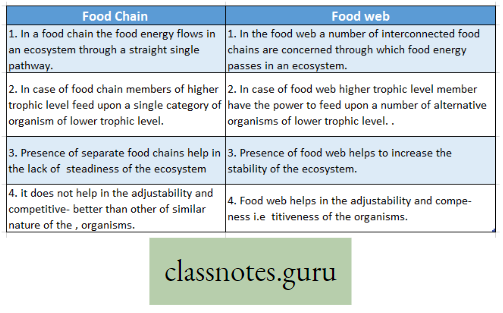
Answer the following :
- What do you mean by phytoplankton?
- What do you mean by zooplankton?
- Mention the two main categories of components of the ecosystem.
- Snake dragonfly, toad and grass arrange them according to the levels of the food chain.
- Write the terrestrial organisms in a sequence who eats whom and ultimately form a chain of at least three steps.
Things to remember
- The functional unit of ecology is the ecosystem.
- The interaction of living organisms with biotic and abiotic components of the environment is known as an ecosystem.
- Stratification is the vertical distribution of different species occupying different trophic levels of the ecosystem.
Energy-Flow Ik Ecosystem :
Explanation: In an ecosystem, energy flows in a definite fashion. The main source of energy is the sun. Green plants synthesize carbohydrates or other food materials by the process of photosynthesis within their body from C02 and water with the help of sunlight. Mineral salts are necessary for this purpose.
For reference only: The rest of the food energy is stored within the plant body. Different types of microorganisms act on the plant body after their death. The microorganism carries out metabolic activities at the expense of decomposed plant materials. As such CO2, nitrogenous compounds, etc. evolve which may be further utilized by the existing plants.
- All animals are dependent upon plants for their food. The animals utilize a part of the food for respiration. CO2 and water produced during the respiration of animals may again be taken up by the plants. Animals get rid of excess mineral salts and certain toxic organic compounds from their body as excretory products which may be further utilized by the plants.
- In the soil after the decomposition of dead animals by the microorganisms, several chemical substances are produced. The plants may utilize these chemical substances.
- Energy never goes back to its source. In other words, the radiating solar energy never returns to the sun.
- The transformation of energy takes place. Green plants capture the solar energy to synthesize food having potential energy stored within its chemical bonds. Such potential energy transforms into kinetic energy during respiration. A portion of kinetic energy is released as heat in the environment that subsequently passes into space.
- Earth receives energy from the sun and loses energy continuously in space, as a result, the total energy content remains the same.
In summary, stages of energy flow in the ecosystem can be explained as follows:
- Source of energy: The Sun is the only source.of energy on earth.
- Fixation of energy: Green plants perform photosynthesis when solar energy is fixed in the form of potential chemical energy in glucose molecules.
- Transfer of energy: Through the food chain and food web energy is transferred from producer to consumer and decomposer.
- Gradual decrease in energy transfer (10 cent law): Raymond Lindeman proposed that in any ecosystem during energy flow, approximately 10% of energy is transferred from one trophic level to another trophic level. Thus amount of “energy transfer” gradually decreases towards a higher trophic level.
- Unidirectional flow of energy: Through the food chain and food web energy always flows from producer to primary consumer, then to secondary consumer and so on in a unidirectional manner.
For reference only:
Stages of energy flow: Now energy flow in the ecosystem takes place in three successive stages :
- Acquisition of energy,
- Uses of energy and
- Unidirectional flow of energy.
Acquisition of energy: The source of energy in the ecosystem is solar radiation. 12-3 x 1022 calories of solar energy reach the earth each year. Of which a major part is reflected in the space due to the presence of clouds, smoke, and dust particles.
- According to German Scientist Rudolf Geiger, about 42% of solar energy is reflected in space due to the presence of clouds, dust particles, etc. in the atmosphere. 10% of the solar energy and ozone, oxygen, water vapour, carbonic acid, etc. are absorbed by the suspended solid particles in the air. In the daytime 48% of the solar energy falls on the earth.
- Some of the light energy is also reflected from the surface of the earth. The remaining light energy is entrapped by the chlorophyll present in the palisade and spongy parenchymatous cells of the mesophyll tissue of the leaf where photosynthesis takes place. As a result, light energy is transformed into kinetic energy which is stored as potential energy in the carbohydrate food matter.
- The primary production in the ecosystem is the production of glucose by the green plants, energy released during this time is called gross production. After respiration and other living processes, the energy left behind is termed net production or NP.

Uses of energy: In an ecosystem, the producers transform solar energy into chemical energy and later in the presence of water and carbon dioxide prepare carbohydrates.
- These plants are taken in by animals and thus potential energy is acquired by them. Again when the secondary consumers feed oh primary consumers they also acquire potential energy. Thus when tertiary consumers take in secondary consumers, we see a similar flow of potential energy to occur.
- Thus, the main source of energy for all animals is food. The amount of energy acquired from food is called gross energy intake and in short, denoted by the letter I.
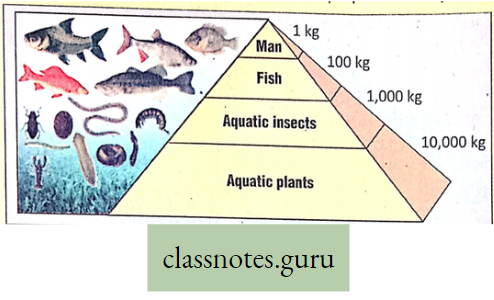
- When energy flows through the different trophic levels of an ecosystem we can see that, some energy is dissipated as heat at each step which is of no use. In the year 1942, Raymond Lindemann formulated the law called the 10 per cent law.
- According to this law, about 10% of total energy is transmitted during energy flow through several trophic levels. That is why we notice a diminution in the amount of energy. Energy used up by a body to function properly is called respiratory energy (R).
- For example, about 100 kg of organic food present in the grass, will make 100 kg biomass in the case of herbivorous animals, and about kg 1 kg biomass in the case of carnivores.
- According to Lindemann’s 10% law, in a grassland ecosystem about 100 kg of grass would increase 10 kg of flesh in the body of a deer. If this deer is taken in by a tiger its flesh would help in increasing 1 kg of flesh in the body of the tiger. Thus a gradual diminution of energy is noticed.
- The formed energy is spent in digestion, metabolism and performing other physiological functions by an animal. Some energy is also liberated as heat and thus lost to the surroundings.
Energy Flow Is unidirectional:
Producers obtain their light energy from the solar energy. This light energy once entrapped by the chlorophyll cannot retrace its path but is given out to the surroundings. Thus, along the trophic level energy gets transmitted step by step but once given out it cannot follow its way back. Thus the energy flow is unidirectional.
- Source of energy of ecosystem Solar energy of the sun.
- Source of energy of living organisms Food.
- Unit of ecology Ecosystem.
Nutrient Cycle:
Nutrient Cycle Introduction: The cyclical movements of the chemical elements i.e. nutrient cycling of the biosphere between the living organism and the environment is called the bio-geochemical cycle. The earth is made up of soil, water, air, and millions of living organisms.
- A continuous exchange of materials and energy takes place between and within these two world. These exchanges occur in cycles, which involve a continuous circulation of substances between organisms and their physical environment.
- Substances such as oxygen, carbon dioxide, water and minerals are constantly absorbed by organisms, but as soon as these substances are lost from the physical world they are replaced by natural processes. There is a balance of nature in which losses equal replacements and in which materials are used and reused over and over again.
- Nearly 30 to 40 elements are required for the proper growth and development of living organisms. The most important of these are C, H, 0, P, K, N, S, Ca, Mg, Fe, B, Zn, Cl, Mo, I and F.
Nutrient Cycling Definition: The principal chemical elements of the biosphere flow from the abiotic to the biotic components and back to the non-living components again in a more or less cyclical manner, forming the bio-geochemical cycle. That is also called nutrient cycling.
Types of bio-geochemical cycles: There are three types the gaseous cycle (Carbon cycle, Oxygen cycle), the sedimentary cycle (Phosphorus cycle, Sulphur cycle) and the hydrological cycle (Water cycle).
Natural Resources And Its Sustainable Use Forest

- Use: Forest functions: A forest in general may be defined as an area set aside for the production of timber, fuel, and bamboo and the forest produces a variety of products of commercial and industrial value or is maintained under woody vegetation for certain indirect benefits which it provides e.g. climate, protective and social functions. The ecological balance of nature is maintained by the forest.
- Watershed protection: In this case, a forest helps to protect an area of land that separates water flowing to different rivers, basins or seas i.e. high-raised areas of good rainfall.
- Atmospheric regulation: Forests influence the temperature of a place. The summer days are cooler and winter days are warmer due to the dense canopy which prevents re-radiation of heat absorbed during the daytime. Forests influence humidity by causing obstruction to wind and keeping air more moist. Water escaping from plants through the transpiration process remains in the air due to the slow movement of air. The litter and humus present in the forest soil provide the insulating effect. The rain-bearing winds cause more precipitation due to forests. Leaves of trees in forests show more condensation of moisture and fog drip. Solar radiation, temperature, wind, and humidity are influenced by forests.
- Erosion control: In forests, the dense canopy formed by branches and leaves of trees prevents the water from reaching the earth with force. The litter and humus present in the forest floor absorb the water. The soil rich in organic matter is porous and permeable. It serves as a natural filtering agent and allows storage of water. Forest soil absorbs more water from melting snow. Forests check soil erosion caused by water. Trees acting as a wind break and shelter belts reduce the removal of fertile topsoil. The roots of trees are great soil binders and. play an important role in controlling erosion.
- Local use: Tree branches are used for building commercial and industrial structures. Newspaper, sports equipment furniture are forest products. Pulpwood, poles, and railway sleepers are made from trees. Cattle grazing is done to a large extent. Rural people earn their livelihood by selling non-timber forest products. Medicinal plants, gums, resins, and edible fungi are forest products. Forests provide fuel and wood for energy.
- Productive use: Forests provide several products such as timber, firewood, fruits and seeds, clothes, furniture, medicine, house building materials, etc.
Forest vegetation prevents excessive stream temperatures by shading the courses of water which is very beneficial for fish life. Forests also help to create clean and clear streams which are very necessary for the fish life to survive in that condition. - Protection of wildlife: Wild animals find their natural habitat in dense forests. Thus forest helps in wildlife conservation.
Cause Of Deforestation And Consequences
Deforestation is the destruction of forests leading to non-forested areas.
For reference only:
Importance of forest: Forests are natural resources for fuel, timber, paper, medicinal plants, fodder, water yield, animal products, etc. They maintain the level of rainfall, by recycling moisture into the atmosphere by transpiration which falls back as rain. Trees conserve this rainwater. Forests help to check flood, and soil erosion and serve as an important habitat for wildlife.
- The tropical rain forests, the most productive type of forests have decreased to about 40 per cent and temperate forests to about 1 per cent. In India, about 30 per cent of land was covered by forests at the beginning of the 20th century. However, it has reduced by about 19-4 per cent by the year 1999.
- In India, areas under dense forests to less than two-thirds of the existing forests and the rest are open degraded forests. National Forest Policy (1988) of India recommends an optimum 33 per cent forest area for the plains and about 67 per cent forest cover for the hills.
Causes of deforestation:
Some of the causes of deforestation are
- Population explosion i.e. sudden increase in number.
- Indiscriminate deforestation by man for agricultural land, cattle ranching, construction of dams, mining, construction of roadways and rail tracks.
- Large-scale felling of trees to meet increased demand for timber, fuel wood, and paper.
- Forest fires destroy trees and animal life.
- Pests destroy trees by eating leaves and boring into shoots.
- Forests are damaged by storms and snow.
- Jhum or Shifting cultivation involves the burning of trees, ashes are used as fertiliser and the land is used for farming or purpose for cattle grazing. –
- Water reservoirs constructed across the streams are used for generating power or prevention of floods.
- Over-exploitation of land resources.
Consequences or effects of deforestation :
- Decrease in groundwater.
- Increase in soil erosion, water and wind erosion v.
- Frequent floods and droughts destroy large numbers of trees.
- CO2 consumption and O2 production were affected adversely.
- Loss of genetic resources.
- Increasing incidents of landslides and avalanches.
- Changes in the pattern of rain.
- Changes in climatic conditions in deforested areas i.e. global warming.
- Loss of biodiversity due to deforestation.
- Deterioration in quality of life of weaker section of people dwelling in forests.
- Flash floods.
- Global warming.
- Soil erosion.
- Due to cyclone, a natural calamity.
- Siltation
- Decrease in the quantity of timber.
- Decrease in the quantity of fuel wood.
- The uprooting of plants and loss of livelihood of indigenous people.
Things To Remember
Afforestation: It is a process of planting trees in an area of land to form a forest. The main objectives of afforestation are to increase the protective and productive outputs.
Water
Introduction: Water is a colourless, odourless liquid which freezes at 0°C and boils at 100°C. It is a compound of hydrogen and oxygen (H20). This liquid possesses some mass, has no shape and size, and exerts pressure in all directions of the container.
- Water is necessary to maintain life. Life cannot survive without water. Water helps organisms to grow and survive and allows easy penetration of light. Rain and snow are the primary sources of fresh water required by living organisms.
- Water is a vital natural resource, which is essential for multiple purposes. Its many uses include drinking and other domestic uses, industrial cooling, power generation, irrigation (agriculture), navigation (transportation) and waste disposal.
- Water is indeed a most essential commodity for human consumption and without it, no life can exist.
- It is one of the most important vital substances in the biosphere which is required for the various metabolic activities of living beings.
- Water is also required in industries for power generation, navigation and disposal of sewage and industrial waste.
- This water is synonymous with life and is gifted with unusual physio-chemical properties.
Use Of Water
- Drinking: Water which is fit for drinking is called potable water. Potable water is clear, colourless, odourless, free from harmful chemicals and coliform bacteria and contains enough amount of dissolved oxygen and no floating impurities. Natural hard water, due to the presence of dissolved salts imparts a refreshing taste is conducive to health and serves the purpose of drinking water.
- Agriculture: Agriculture is, in fact, a form of applied Biology.
For reference only: As we have discussed earlier, every living thing exists in inter-relations with other living things in some form or other, as well as with the surrounding physical conditions.
- The earthworm burrows the soil as a ‘natural tiller’ which helps to aerate and enrich the soil by keeping it permeable to water, the insects which pollinate the crop plant and the bacteria of putrefaction which restore nutrients to the soil. These are then, as much a part of agriculture as special crops grown.
- Agriculture, in reality, is largely the result of man’s taking advantage of these inter-relations of soil, climate and natural inhabitants to select those particular combinations that meet his requirements.
- Thus, to provide necessary food man depends entirely on green plants, which alone can captivate solar energy through which proteins, fats and carbohydrates are prepared.
- Irrigation is to supply water to land for the cultivation of crop plants. Water requirements for irrigation are by far the highest among various uses of fresh water.
For reference only: The amount of water required for irrigation purposes varies with the climate of the. region and the type of crops that are to be raised.
- Surface waters used for irrigation may be diverted through canals which afford gravity-aided flows to the irrigation area. Where the lands to be irrigated lie above the river, lift irrigation may be required.
- The total quantity of water used for irrigation is rather large. According to an estimate, about 41% of all the water used in the USA is for irrigation.
- It is estimated that nearly 3,500 litres of water per person per day are used just for irrigation.
- This quantity is several times higher than the average domestic demand.
- Estimates show that for obtaining 1 kg each of wheat, rice, meat and milk about 600, 2,000 25,000 and 400 litres of water are required, respectively.
Industry: Industry uses more water than any other commodity.
For reference only: According to estimates, more than 630 billion litres of water is consumed per day by industry in the USA. One ton of steel making consumes about 3,00,000 litres of water. For making an average automobile, about 4,50,000 litres of water is needed.
- Most of the water used by industry is for cooling and processing. For. example, water cools the hot gases produced in refining oil and hot steel in steel mills. Industry is very dependent on adequate water supplies. The enormous demand that industry has for water is indicated by the water requirement of some key industrial processes.
- The quantities of water used by industry vary widely. Major water users are steel, pulp and paper, textiles, chemicals and petroleum refining; they account for nearly 80 per cent of industrial water demand. Accurate projected requirements are not easily available for various industries in India.
- With a growing population, the demand for freshwater is steadily increasing in India, but as with all other resources, there is a limit to fresh water supply. In addition, the availability of high-quality water is dwindling because of misuse, waste and pollution.
Use of Water For Various Other Purposes:
- Used for daily household work like cooking, washing, bathing, cleansing, cleaning, etc.
- Used in industries.
- Used in chemical laboratories as solvents.
- Used for performing biochemical reactions.
- Used in the production of medicines.
- Used for navigation purposes.
- Used in photography.
- Used in textile and paper industries.
- Used in aquaculture and pisciculture.
- Water can dissolve gases like carbon dioxide and oxygen.
- Over-utilisation of Water And Water Scarcity
For reference only:
- Scarcity of water results from a lack of sufficient water resources to meet the demands of water users within a region. Groundwater forms the biggest reservoir of fresh water on earth and is used for agricultural, industrial and domestic purposes.
- Water is used for drinking, bathing, washing, irrigation, industry, cooling, construction work, sewage disposal, and disposal of industrial effluents. Water influences the ecosystem by affecting climate, erosion and providing life for biodiversity.
- Excessive use of groundwater may cause a fall in the water table. When the amount of water used exceeds than amount of water obtained through precipitation, a deficit in the water supply takes place. Depletion of groundwater levels may lead to contamination of drinking water. Stream flows and lake levels are also affected. Reduction in stream flow intrusion of salt water and variation in estuarine salinities results from overuse of water.
- When freshwater resources are overutilized aquatic ecosystems both marine and fresh v/ater are destroyed, several species become extinct, and water-related diseases spread out. Such problems arise with the rise in human population.
- Proper planning and management are required to sustain ecosystems and maintain human health. Water scarcity may indirectly lead to a shortage of food due to a reduction in agricultural productivity and poor living conditions. Overuse of v/ater in an area may cause a change in the climate condition of that area. Desertification may occur.
- Water needs to be conserved. Wide-scale adoption of lav/ for irrigation systems like drip, micro sprinklers and automation is used in agricultural lands to decrease v/ater requirement.
- In domestic and urban sectors conservation of water is focussed on proper monitoring of municipal water systems—their repair and control whenever necessary. All citizens should be aware of proper use of water and avoid misuse of this natural resource. Public water conservation campaigns are necessary to awareness of water scarcity.
- Our planet, earth, has a fixed amount of water. The distribution of vectors varies from place to place. The amount of fresh water available is sufficient to meet our needs. Despite that, there is a global shortage of water in usable form. This is because v/e don’t use water judiciously and a lot of water remains unutilised or wasted.
- Water from the atmosphere reaches the earth’s surface through rainfall and from the earth’s surface, it reaches the atmosphere through evaporation and transpiration. This continuous exchange of water from the earth to the atmosphere and vice versa is maintained by nature, through the water cycle.
Causes of Scarcity of water :
- Scarcity of water due to drought: Water scarcity occurs sometimes due to severe drought conditions. It is due to a lack of rainfall for a sufficient duration. Severe droughts, result in a reduction in ground water level, and the destruction of grasslands, pastures and crops.
- Scarcity of water due to misutilisation of water: Improper utilization and distribution of water and deterioration of water quality cause water scarcity. This problem can be solved by recycling water at the local level.
- Scarcity of water by other causes: The other reasons for the scarcity of water are the depth of water is decreased due to soil erosion and most of the Water bodies are filled up for human habitats. Water also getting polluted due to several reasons.-Further, deforestation results in less rainfall.
- Hence water scarcity causes great problems to the living world. It affects the lives of humans, aquatic plants, animals and microbes due to which the ecosystem is going to be unbalanced causing hazards for human beings.
Water conservation: To meet the water scarcity problem water has to be conserved by the following methods.
- Proper distribution and utilization of water.
- Proper drainage methods are to be implemented.
- Proper storage of water by digging ponds and tanks and building dams and irrigation canals.
- Proper maintenance of ponds, pools, jheels, lakes, etc.
- Floods should be controlled by constructing dams.
Reasons For Water Scarcity :
- Depletion and deterioration of available and usable water resources.
- Droughts and floods.
- Increased pollution.
- Increased human demand for water.
- Overuse of water.
- Lack of means to provide water to meet household, industrial, agricultural and environmental needs.
- Increase in human population.
- Lack of access to safe drinking water.
Rainwater Harvesting
- The basic source of water is rainfall. Rainwater can provide a solution when water quality falls or varies during the rainy season.
- To store and obtain water according to necessity dams, lakes, and canals were made.
- The rainwater harvesting technique is used to store rainwater in special water harvesting structures like wells, pits, dams, lagoons, etc.
- This form of harvesting rainfall benefits all particularly in. areas where rainfall is scarce.
- A severe shortage of water may occur. Growing trees in watershed areas increases the retention of rainwater and protects soil from erosion.
- Rooftop rainwater harvesting forms one of the best methods of harvesting rainwater.
- This is a simple and low-cost technique requiring minimum knowledge.
The rainwater harvesting system consists of three basic components:
- Roof surface for collection of rainwater,
- gutters and drain pipes are required for the transport of water from the roof to the storage reservoir,
- Storage tanks or reservoirs are used to store water.
- Rainwater from the rooftop is drained into a storage pit or tank and stored for future use.
- This water may be used for irrigation or domestic purposes.
- Water from the storage tank when passed through the filter may be used as drinking water.
- System of harvesting of water in rooftops.

- The advantage of rainwater harvesting on rooftops is a simple and low-cost technique. Such a system can be trained well.
- The water obtained is of good quality. Such a system causes no harm to the environment. Rainwater harvesting has several advantages.
- It reduces runoff water and checks soil erosion, controls flood supply water during dry months. Rainwater helps increase the level of the water table.
- Water harvesting is a necessity in areas which are arid and semi-arid with scanty rainfall.
Disadvantages of rainwater harvesting:
- Water supply problems may arise during droughts.
- The supply of water depends on the amount of rainfall.
- In the rooftop form of rainwater harvesting and dams, regular inspection, cleaning and repairing are required.
- In the rooftop form of water harvesting rainwater may be contaminated with air pollutants, animal or bird droppings, insects, etc.
Case Study
- A chronic shortage of water has been going on in Israel for years due to drought leading to a water crisis in recent years. The deficit in renewable water resources caused the depletion of potable water resources.
- Due to the deficit of the qualitative deterioration of drinking pure water resources which become either of brackish quality (slightly salty) or otherwise become polluted causing a problem in solving the severity of the present crisis, whereby water supply was drastically minimised.
- Increased population and rise in standard of living caused overutilization of water resources. The agricultural sector suffered due to this crisis.
Understanding the relative importance of changes long-term perspective institutional and operational is required in this connection to stabilize the situation.
Water Scarcity Problem Australia (A case study)
- Water scarcity is the lack of sufficient available water resources to meet the demands of water usage within a region. It involves water stress, water shortage and water crisis.
- In Australia, climatic change and variability show an abundance of water in the tropical north with fewer inhabitants and a relative scarcity of water in the densely populated temperate south.
- In the south rainfall is less and the governance system is poor.
- Overuse of surface and groundwater supplies and increased requirement of water in fields of irrigation, domestic purposes, and mining, leads to scarcity of water.
- The population and agricultural activities are concentrated where the resources of water are limited. A balance between the extraction of water for irrigation and maintenance of environmental flow in rivers to required.
- The health of rivers, groundwater, wet: lands, flood plains and estuaries depends on land management factors like drainage, nutrients, and chemical pesticide loading.
Investment in plantation, farm forestry and general revegetation may form a landscape with the potential to treat the cause of land and water degradation problems. The Council of Australian Governments (CoAG) response to this water issue is developing an intergovernmental agreement called the National Water Initiative (NWI).
- The objective is to increase productivity and efficiency of water use, better service to rural and urban communities, ensure the health of the river and groundwater system of planned trading and sustainable use of water, and the inclusion of reform processes for improving water use efficiency and productivity.
- Reallocation of water between irrigation activities from irrigation to river and groundwater flow and some movement of water from irrigation to urban use.
- Recycling and reuse of water is essential. Water productivity may be increased by growing more food with less water.
- Shifting of water use by trading from low-value crops to high-value crops.
- Important causes of water scarcity are population expansion, urbanisation and the growing need for sewage, cleaning, manufacture, and pollution contributing to a reduction in water quality. Deforestation and destruction of vegetation cause drying of soil and climatic changes.
Know the Facts
A list of countries with populations affected due to water scarcity is given below :
- SUDAN-12-3 million
- VENEZUELA-5-0 million
- ETHIOPIA-2-7 million
- TUNISIA 2-1 million
- CUBA 1-3 million
Food Source
1. Agriculture: Agriculture, as a whole, is a form of applied biology; since every living thing exists in complex inter-relations with other living things. Modern man, unlike his primitive ancestors, does not depend upon fishing and hunting, lie cultivates plants arid rears fish as well as cattle and other domestic animals to get food and other necessities of life. Better and reproductive varieties of crop plants, such as rice, wheat, jute, sugar cane, pulses and cotton are now bred experimentally. Disease-resistant grains are raised and seeds are vernalised by special treatments to yield the crop before the usual time of harvesting.
2. Horticulture: The art or practice of cultivating and changing gardens. It deals with the science of growing flowers, fruits, vegetables, and ornamental plants. Improvement of crop plants both qualitatively and quantitatively is not possible without the knowledge of biology. Hybridisation techniques and modern methods of cultivation are being used for the production of new varieties of economically important plants. The use of disease-resisting varieties increases the production.
- Application of breeding techniques resulted in the improvement of livestock (cattle, sheep, poultry) with an improved yield of milk, meat, wool arid eggs. Improved and productive varieties are raised through selective breeding.
- Plant breeding plays an important role in the improvement of crop plants. Increased yield of cereals like wheat, paddy, Jowan, Bazra, and Maize, and improvement in quality and yield of legumes like pea, gram, and bean, were possible by applying various techniques of plant breeding. This resulted in increased production and helped to minimise the problem of food scarcity. This period in the middle of the 1960s was referred to as the Green Revolution. Plant breeding systems developed high-yielding disease-resistant varieties for enhancing the production of food.
3. Animal husbandry: The World is facing an acute shortage of foodstuff due to the very high rate of increasing human population. Different animal sources are utilized for enhanced food production. These include poultry, dairy firm management and animal breeding. The techniques of embryo transfer, tissue culture, induced breeding, etc. are also practised.
- Live stock includes domesticated farm animals such as cows, buffalo, sheep, etc. reared to get meat and milk. Meat animals are cows, buffaloes, goats and sheep. The milk animals include cows, buffaloes, etc.
- Besides meat and milk, some animals are domesticated on farms for multiple purposes. These animals include horses, camels, bulls, deer, yaks and poultry birds. Birds like chickens, turkeys, ducks and geese are known as poultry birds which are reared for meat and egg.
- Fisheries also provide an important source of animal food, concerned with rearing, catching and selling fish, molluscs (shellfish and crustaceans (prawns, crabs, etc.). The practice of apiculture beekeeping is another source of food as honey.
Role of animal husbandry in human welfare: Animal husbandry can be used to obtain a lot of benefits for mankind which are as follows
- Dairy products: Milk and other dairy products such as yoghurt, cheese, paneer, butter, ice cream, etc. could be obtained.
- Meat: The demand for protein is mainly covered by cattle and other animals.
- Land management: Grazing by live stocks can be used to control the growth of weeds
in the agricultural field. - Labour: Horses, donkeys, yaks, etc. can be used as mechanical carriers.
- Fibre: Sheep provides fur or wool for the textile industry.
- Fertilizer: Cow dung can be used as manure for the crop field. The blood and bones of animals also used as fertilizer
- Fishery: Fish can supply us with different types of easily digestible animal protein on one hand, and on the other, it may serve as a good source of nutritive and palatable food. Besides different types of vitamins and minerals are also present in fish. It is with an eye to the above that the entire world is earnestly trying to develop and improve pisciculture and increase its fish production.
Fisheries provide an important source of animal food, concerned with rearing, catching and selling fish, molluscs (shellfish) and crustaceans (prawns, crabs, etc).
Alternate food sources: Food energy is provided by cereal grain forming staple foods example maize, wheat, and rice. Bacteria and fungi are used for preparing bread, alcoholic drinks, cheese, pickles, yoghurt, etc. Bluegreen alga Spirulina is also used as food.
- Plant seeds form a good source of food for animals and humans. For example, cereals (Maize, rice, wheat) legumes (peas, beans, lentils) and nuts.
- Oil is produced from oilseeds of sunflower, rape seed, sesame. Fruits eaten as vegetables are tomatoes, pumpkins, eggplants, etc. Potatoes, carrots (root vegetables), onion (bulb), spinach and lettuce (leaf vegetables) bamboo shoots (stem vegetables), and broccoli (inflorescence vegetable) are used as food.
- Animal sources of food are meat (muscle or organ of animals taken as food). Milk and dairy products formed by processing it (cheese, butter) are consumed as food. Honey produced by bees, and eggs laid by birds, are latten as food. Several organisations deal with agroecosystem soil fertility and biodiversity.
- Fungi used as food are mushrooms like Agaricus campestris, A bisporus, and ‘morels’ (Morchella esculenta). Some species under the genus Tuber (called truffles) are used as food. Pleurotus are sold as fresh mushrooms. Lycoperdin sp (puffball) are edible fungus. ‘Sufu’ a food is produced from Mucor. Saccharomyces cerevisiae (yeast) is used to produce yeast cake.
Some edible forms of algae are Laminaria, Alaria, Sargassum, Porphyra, Ulva, Chlorella, Chondrus, and Rhodymania, stipes and blades of seaweeds are used as food. Red alga Porphyra tenera is an edible seaweed, rich in protein, carbohydrates, and vitamins A, B, and C. ‘Kombu’ a food in Japan is prepared from Laminaria (a seaweed). Diatoms are also used as food. Brown alga (Sargassum) is also used as food.
- Bryophytes like mosses (for example Polytrichum ) provide food for herbivorous mammals, birds and other animals.
- The stalks and leaves of the Pteridophytic plants like Marsilea, Dryopteris, and Pteris. etc. are used as vegetables, especially during the scarcity of food.
- The seeds and young shoots of Cycas, a gymnosperm taken as food. The seeds of Pinus gerardiana, popularly known as chilgoza, can be taken as food after roasting. Gnetum ula seeds are also edible.
World Food Problem (case study) And Its Effect: Food problems arise from the lack of effective production of food required by people. The food problem is caused due to
- slow down the yielding rate of the main cereal staple,
- Damage caused to the environment
- Resistance to pesticides
- Higher food prices
- Increased population
- Distribution of food and individual access to food
- Increasing urbanization
- Intensive farming and irrigation system.
Priority should be given by several organisations to agricultural research and investments to increase agricultural productivity and production.
- Research should be planned in a way that the changing geographical and socio-economic characteristics of hunger are taken into account along with the perception of malnutrition-related problems by poor people.
- One of the serious earliest food scarcity in the form of famine faced by the people of the then Bengal before partition caused the death of a good number of people; which is stated below.
- Famine broke out in 1776. Many people died. The famine affected Bengal mostly. At that time Capital of Bengal was Murshidabad. Bengal was connected with Bihar and Orissa. In Bengal, this famine is popularly known as “Chiattarer Mannahtar”.
Famine and Food Insecurity in Ethiopia A Case Study: Ethiopia, the second most populous country in Sub-Saharan Africa has a population of about 75 million people. With a tropical monsoon climate and highly erratic rainfall, Ethiopia shows drought conditions.
- Agriculture is the primary source of livelihood and farmers rely on technologies which are traditional for producing yield mainly used for consumption.
- Farmers used local seeds from previous harvests. Limited use of chemical fertilizers, and obsolete tillage practices with efficient tillage tools were reasons behind low productivity.
- Ethiopia experienced famines of which the worst one took place between 1983-1985. The cause behind the famine was the failure of rainfall and the loss of livestock.
- Many people were affected and many died. The famine had long-term effects on the poor who sold their assets for their survival and had to face future crises.
- In 2002, there was another famine as an increase in production and lowering of prices led to food insecurity.
- The government of Ethiopia reached out to the international community for assistance.
- Though the food was available in the domestic market, the government did not have the money to buy this food for redistribution.
- Soil infertility due to erosion adversely affected agricultural productivity.
- Market failures resulted from a lack of access to modern transport by the majority of the rural people. They were unable to reach grain markets in the major production zones.
- Restriction from access to market information leads to market failures.
- Lack of specialization of wholesalers and low levels of commercial processing, rapid population growth were important causes of famine.
- Too small landholdings, lack of potable water. Inadequate incomes of farmers due to low agricultural productivity and lack of economic incentives caused hunger, malnutrition and disease among the poor farmers.
Energy Use
The capacity to do work is called energy. All forms of energy are mutually convertible one into another. The quantity of work done in the process of transfer is a measure of energy. Therefore, work units are commonly used as energy units.
Growing energy needs: One of the factors playing an important role in the process of economic growth of a nation is energy. The development of power resources in an organised manner results in the industrial development of a country.
- The requirement of energy is indispensable in the fields of agriculture, transport, business and domestic purposes. Electricity is used for various purposes and its wide range of applications in economic development in modern times shows the material advancement of a country.
- Economic growth depends on energy which is the ability or capacity to do work. The different forms of energy in use are electrical energy thermal energy, light energy, mechanical energy, chemical energy, etc.
- In SI units energy is measured in joules. The range of energy consumption in developed countries ranges from 5 to 11 kw, whereas the range varies between 1 to 1-5 kw in developing countries.
Uses of energy: The economic growth of a nation depends on energy which is indispensable in agriculture, transport, business and domestic areas in the form of electric energy, thermal energy, and light mechanical chemical energy.
- A Building uses less healing and cooling energy to achieve and maintain a comfortable temperature when the rooms are insulated.
- The use of fluorescent lights and skylights lessens the energy requirement for attaining the same illumination level. When compared to traditional incandescent lights.
- Improved energy efficiency will reduce the world’s energy needs and reduce carbon dioxide emissions.
- Energy is required in industries, transport, commerce telecommunication, household and industrial sectors.
Wastage of energy Or Energy conservation in daily life :
- Electric lights should not be used during the day when there is natural light. Maximum use of daylight is necessary.
- When short distances are involved walking is the best way. It saves petrol on the one hand and provides good exercise on the other hand.
- Papers must be reused.
- Polythene bags should not be used. The use of cloth bags and paper bags is a better option.
- The use of solar heaters saves energy. ‘
- Planting of trees ensures the purification of air.
- Turning off unnecessary lights.
- Improving lighting maintenance.
- The use of insulating glass, insulated hot water pipes; and storage tanks saves energy.
- Selection of refrigerator and freezer sizes according to family’s needs. Larger ones require more energy.
- During cooking, pots and pans with flat bottoms need to be used. Pressure cookers to be used.
- Air filters on exhaust fans need to be cleaned for better performance.
- Turning off iron minutes before finishing ironing and ironing the clothes with the heat remaining in the iron.
- The oven door should not be opened frequently while in use, as a considerable amount of heat escapes each time the door is open.
- Avoid opening the door of the refrigerator now and then as the compressor has to run a bit longer to replace the cool air that spills out for it.
- Wattages of incandescent light bulbs must be checked. The use of lower-wattage bulbs saves energy. The use of fluorescent lamps produces about four times as much light per watt as incandescent bulbs.
The most effective way to save energy is to improve operations and maintenance.
- Nowadays, alternative sources of energy have been discovered and are used in many places.
- For example, solar energy, solar batteries, solar cars; use of windmills; hydroelectric power etc.
